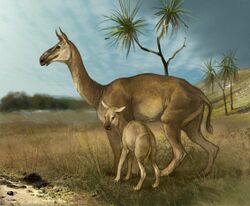Biology:Panperissodactyla
| Panperissodactyla | |
|---|---|

| |
| Collage of living perissodactyls, clockwise from left: plains zebra (Equus quagga), Indian rhinoceros (Rhinoceros unicornis) and Brazilian tapir (Tapirus terrestris) | |

| |
| Macrauchenia patachonica (Litopterna) | |
| Scientific classification | |
| Domain: | Eukaryota |
| Kingdom: | Animalia |
| Phylum: | Chordata |
| Class: | Mammalia |
| Mirorder: | Euungulata |
| Clade: | Panperissodactyla Welker et al, 2015[1] |
| Subgroups | |
|
[see classification]
| |
Panperissodactyla ("all perissodactyls", alternatively spelled Pan-Perissodactyla[2]) is a clade of ungulates containing living order Perissodactyla (odd-toed ungulates) and all extinct ungulates more closely related to Perissodactyla than to Artiodactyla (even-toed ungulates).[1]
Groups thought to belong to this clade include Anthracobunia (including the families Anthracobunidae and Cambaytheriidae) known from the Paleogene of the Indian subcontinent,[3][4] as well as the South American native ungulate groups Litopterna and Notoungulata.[1] Other South American native ungulate groups also possibly belong to the clade, but their placement is uncertain.[5] The enigmatic aquatic Desmostylia have also been suggested to be related to perissodactyls in some studies, though others recover them as members of afrotherian clade Tethytheria.[6] The Northern Hemisphere "condylarth" group Phenacodontidae has been placed as closely related to perissodactyls in some studies, though others recover it as unrelated.[1]
Classification and phylogeny
History of phylogeny
Panperissodactyla was coined in 2015, to include all mammals more closely related to living perissodactyls than to any other living mammals, following a proteomic study which found Notoungulata and Litopterna to be closely related to Perissodactyla.[1] Panperissodactyla is preferred over the older Mesaxonia which was originally coined by Othniel Charles Marsh in 1884, as equivalent to the modern Perissodactyla. Richard Owen's original definition of Perissodactyla included the modern members in addition to the now known to be unrelated Hyracoidea. The name Mesaxonia was resurrected by Martin S. Fischer in 1989 as a replacement for Perissodactyla.[4] Perissodactylamorpha a clade coined to include Anthracobunia and Perissodactyla, is thought to be a subgroup of Panperissodactyla, as Anthracobunia is suggested to be more closely related to Perissodactyla than Notoungulata and Litopterna are.[4]
Taxonomy
- Clade: Pan-Perissodactyla (Welker, 2015)[1]
- Family: †Phenacodontidae [?][1] (Cope, 1881)
- Order: †Litopterna[1] (Ameghino, 1889)
- Order: †Notoungulata[1] (Roth, 1903)
- Clade: Perissodactylamorpha (Rose, et al. 2020)[4]
- Order: Perissodactyla (Owen, 1848) (odd-toed ungulates)
- Clade: †Anthracobunia[4] (Ginsburg, 1999)
- Genus: †Radinskya [?][4] (McKenna, 1989)
- Family: †Anthracobunidae[3] (Wells & Gingerich, 1983)
- Family: †Cambaytheriidae[3] (Bajpai, 2005)
- Order: †Desmostylia [?][3][7][4] (Reinhart, 1959)
References
- ↑ 1.0 1.1 1.2 1.3 1.4 1.5 1.6 1.7 1.8 Welker, Frido; Collins, Matthew J.; Thomas, Jessica A.; Wadsley, Marc; Brace, Selina; Cappellini, Enrico; Turvey, Samuel T.; Reguero, Marcelo et al. (March 18, 2015). "Ancient proteins resolve the evolutionary history of Darwin/'s South American ungulates". Nature 522 (7554): 81–84. doi:10.1038/nature14249. ISSN 1476-4687. PMID 25799987. Bibcode: 2015Natur.522...81W. http://eprints.whiterose.ac.uk/91438/1/Welker_postprint.docx.
- ↑ Nicolás R. Chimento; Federico L. Agnolin (2020). "Phylogenetic tree of Litopterna and Perissodactyla indicates a complex early history of hoofed mammals". Scientific Reports 10 (1): Article number 13280. doi:10.1038/s41598-020-70287-5. PMID 32764723. Bibcode: 2020NatSR..1013280C.
- ↑ 3.0 3.1 3.2 3.3 Cooper, L. N.; Seiffert, E. R.; Clementz, M.; Madar, S. I.; Bajpai, S.; Hussain, S. T.; Thewissen, J. G. M. (2014-10-08). "Anthracobunids from the Middle Eocene of India and Pakistan Are Stem Perissodactyls". PLOS ONE 9 (10): e109232. doi:10.1371/journal.pone.0109232. PMID 25295875. Bibcode: 2014PLoSO...9j9232C.
- ↑ 4.0 4.1 4.2 4.3 4.4 4.5 4.6 Rose, Kenneth D.; Holbrook, Luke T.; Kumar, Kishor; Rana, Rajendra S.; Ahrens, Heather E.; Dunn, Rachel H.; Folie, Annelise; Jones, Katrina E. et al. (2019-11-11). "Anatomy, Relationships, and Paleobiology of Cambaytherium (Mammalia, Perissodactylamorpha, Anthracobunia) from the lower Eocene of western India" (in en). Journal of Vertebrate Paleontology 39 (sup1): 1–147. doi:10.1080/02724634.2020.1761370. ISSN 0272-4634. Bibcode: 2019JVPal..39S...1R. https://www.tandfonline.com/doi/full/10.1080/02724634.2020.1761370.
- ↑ Kramarz, Alejandro G.; Macphee, Ross D. E. (March 2023). "Did some extinct South American native ungulates arise from an afrothere ancestor? A critical appraisal of Avilla and Mothé's (2021) Sudamericungulata – Panameridiungulata hypothesis" (in en). Journal of Mammalian Evolution 30 (1): 67–77. doi:10.1007/s10914-022-09633-5. ISSN 1064-7554. https://link.springer.com/10.1007/s10914-022-09633-5.
- ↑ Matsui, Kumiko; Tsuihiji, Takanobu (2019-10-17). "The phylogeny of desmostylians revisited: proposal of new clades based on robust phylogenetic hypotheses" (in en). PeerJ 7: e7430. doi:10.7717/peerj.7430. ISSN 2167-8359. PMID 31637114.
- ↑ Qiu, L. (2014-10-08). "Ancient "Oddball" Mammal Reshuffles Family Tree?". National Geographic Society. http://newswatch.nationalgeographic.com/2014/10/08/animals-science-paleontology-fossils-evolution-rhinoceroses-elephants/.
External links
- "Systematics of Placental Mammals -- Mesaxonia". https://ucmp.berkeley.edu/mammal/mesaxonia/mesaxonia.html.
Wikidata ☰ Q6821149 entry
 |

